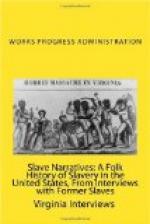Nancy did not remember any stories about witches, booger-men or animals, but she did give a version of the story of the mistress who was buried alive.
“Dat really did happen in Edgefield,” she said. “Marster los’ his daughter and den his butler went to de cemetery and dugged her up. He was gittin’ de jewelries off of her finger when she moan; ’Oh, you hurtin’ my finger!’ He runned back to de house and she got up out of de coffin and went to de Big House. She knock on de door and her father went, and he fainted. Her mother went, and she fainted. Everyone went to de door fainted. But her father come to himself and he was so happy to have his daughter back, he said God let de man dig her up and git her out alive. He made dat nigger rich. Gin him a whole plantation and two big carriage horses and a great big carriage and I dunno how much gold and silver. Told him he didn’ want him to do anything but sit down and live off of what he gin him de res’ of his life.”
Nancy asked her visitor to write a postcard to her “dear doctor” in Louisville and tell him she was having a hard time. She insisted that the card be signed: “Your Carrie Fryer what used to work for you, with love.”
“Come back and see me some more,” she begged wistfully, “I bin callin’ you in my mind all week.”
PLANTATION LIFE
ANDERSON FURR, Age 87 298 W. Broad Street Athens, Georgia
Written by:
Sadie B. Hornsby [HW: (white)]
Athens
Edited by:
Sarah H. Hall
Athens
Leila Harris
Augusta
and
John N. Booth
District Supervisor
Federal Writers’ Project
Residencies 6 & 7
Anderson Furr’s address led the interviewer to a physician’s residence on Broad Street, where she was directed to a small frame house on the rear of the lot. The little three-room cottage has a separate entrance from Pulaski Street. Three stone steps lead from the street to the narrow yard which is enclosed by a low rock coping. Anderson rents only one room and the remainder of the house is occupied by Annie Sims and her husband, George, who works at the Holman Hotel.
Reclining comfortably in a cane-backed chair, with his walking stick conveniently placed across his knees, Anderson was enjoying the shade of a wide spread oak tree in the tidy yard. His costume consisted of a battered old black felt hat, a dingy white shirt, dark gray pants, and scuffed black shoes. Asked if he remembered the days when the North was fighting the South for his freedom, Anderson replied: “‘Member fightin’! Why, Lady! Dey ain’t never stopped fightin’ yit. Folks has been a-fightin’ ever since I come in dis world, and dey will be fightin’ long atter I is gone.
“I dis’members what was de name of de town whar I was borned, but it was in Hall County. Lydia and Earl Strickland was my Ma and Pa. All of deir chillun is daid now ’cept me and Bob. De others was: Abe, Bill, Jim, and Sarah. Dere ain’t much to tell ’bout what us done dem days, ’cept play and eat. Dem what was big ’nough had to wuk.




